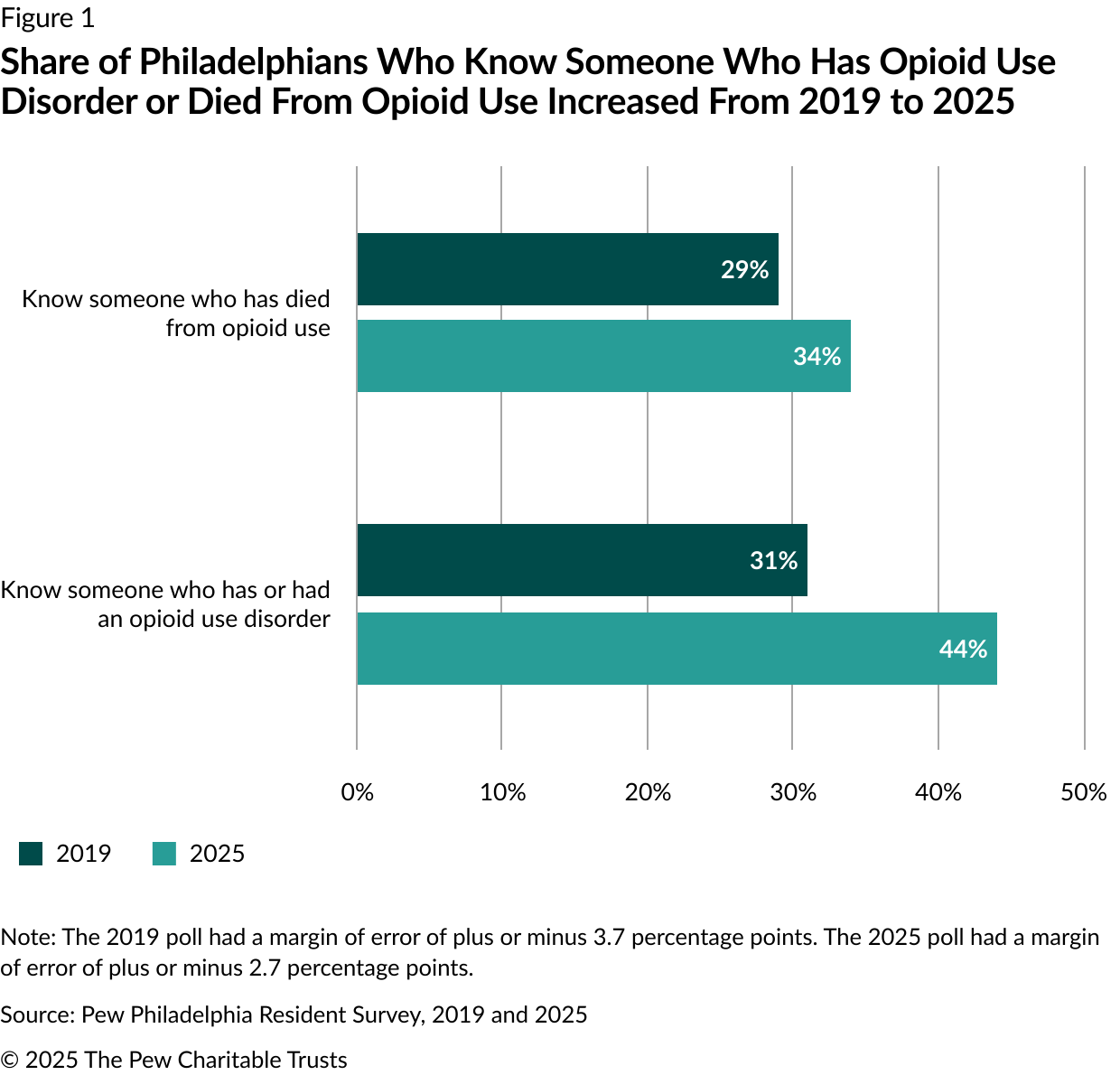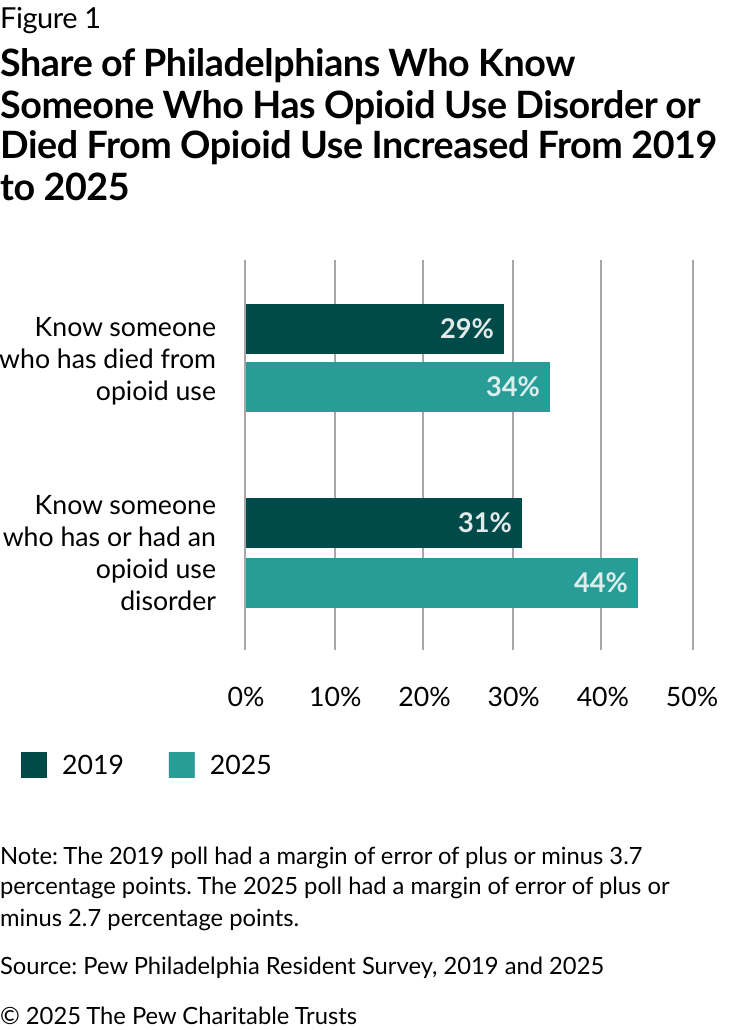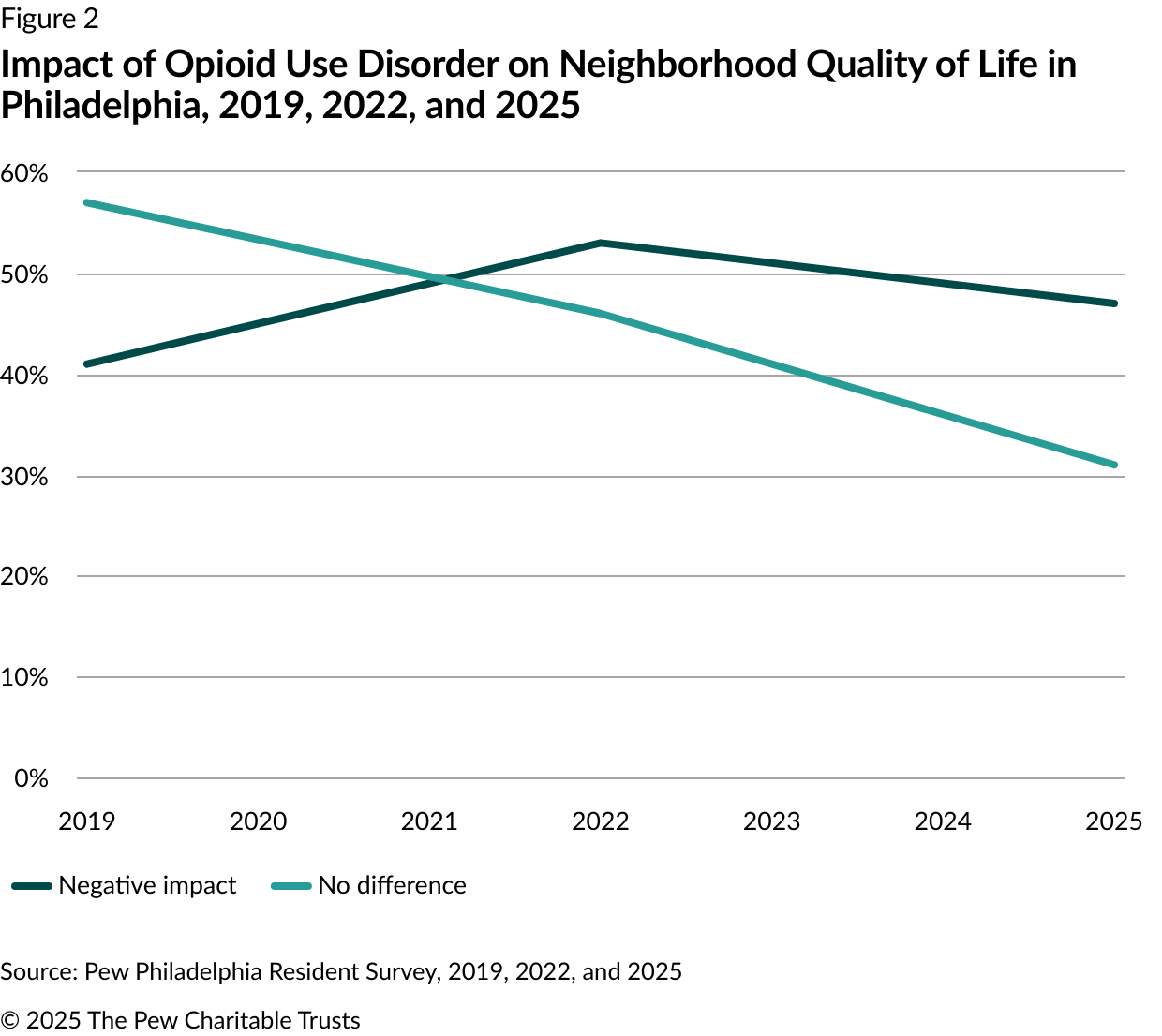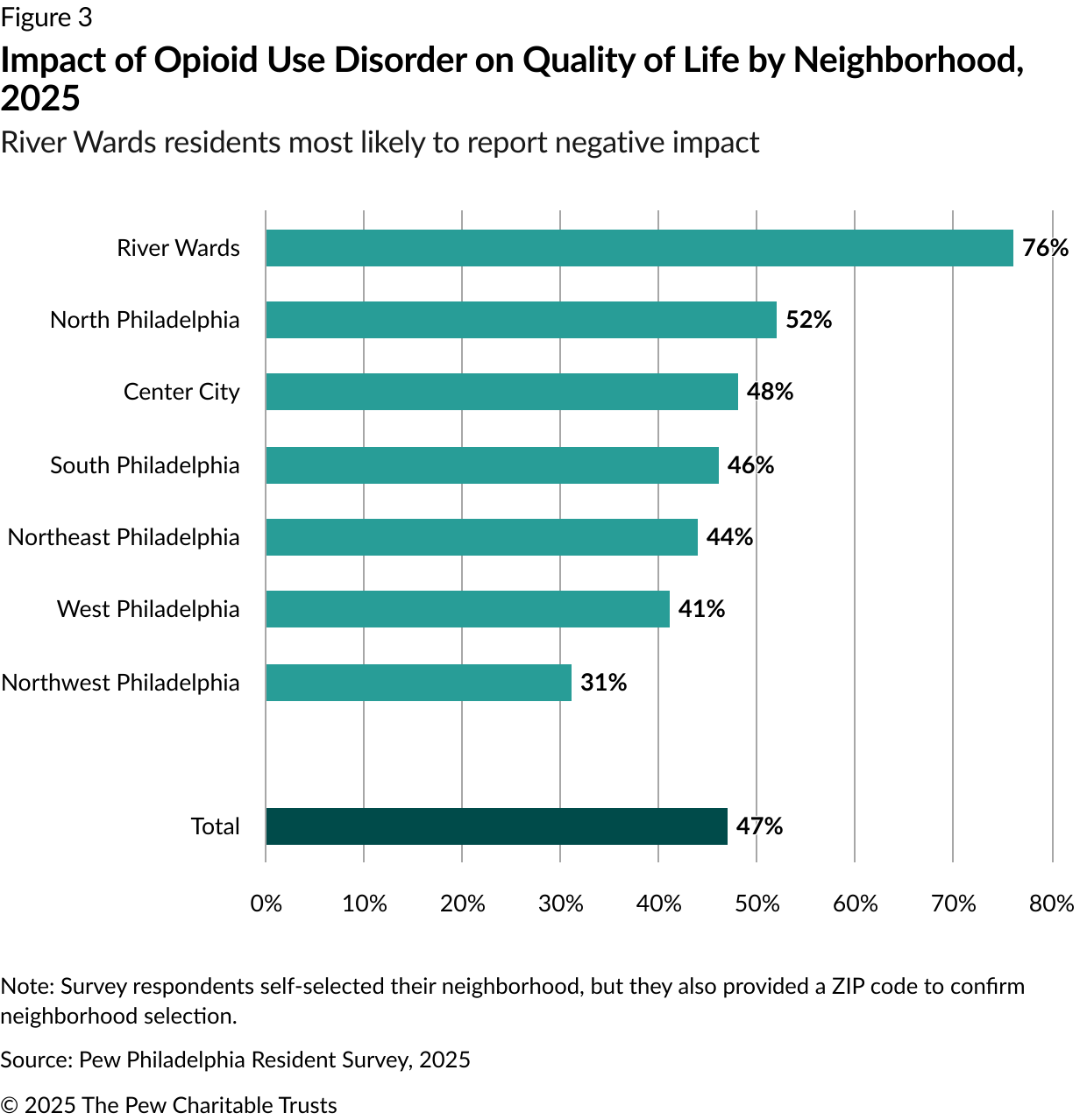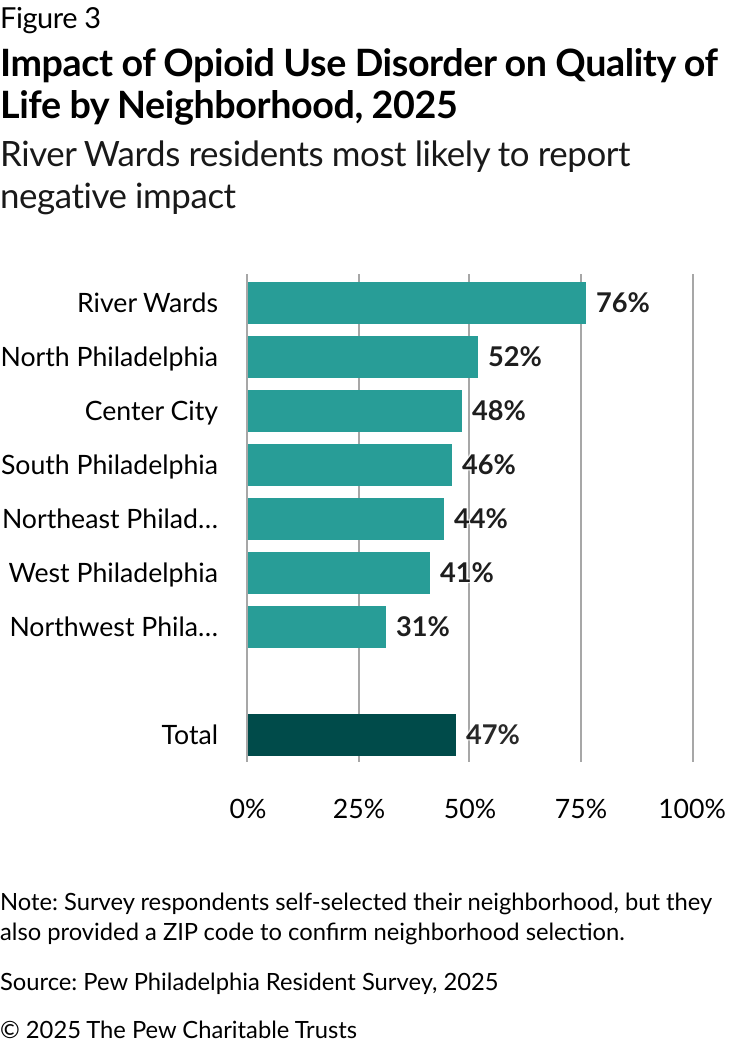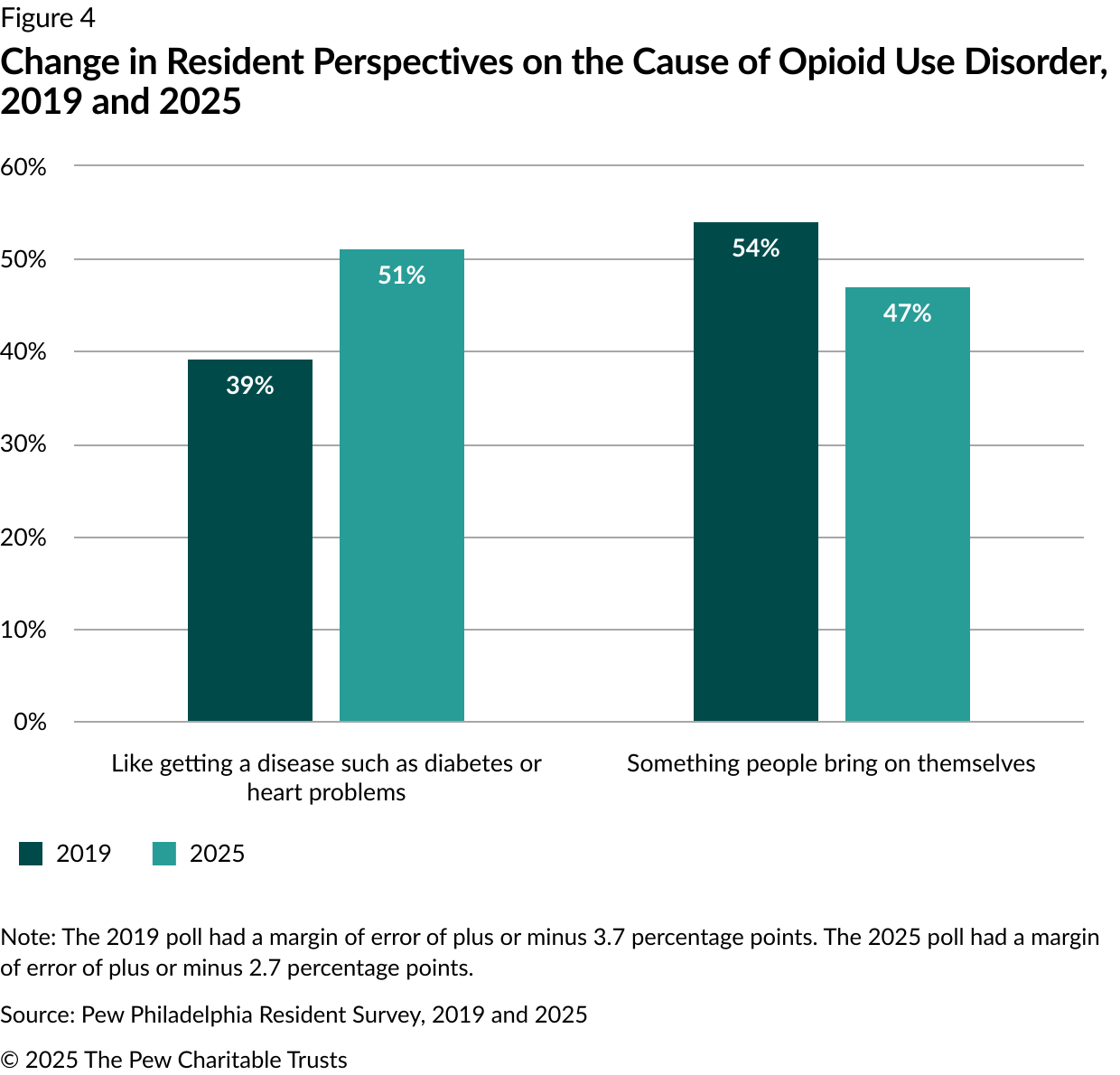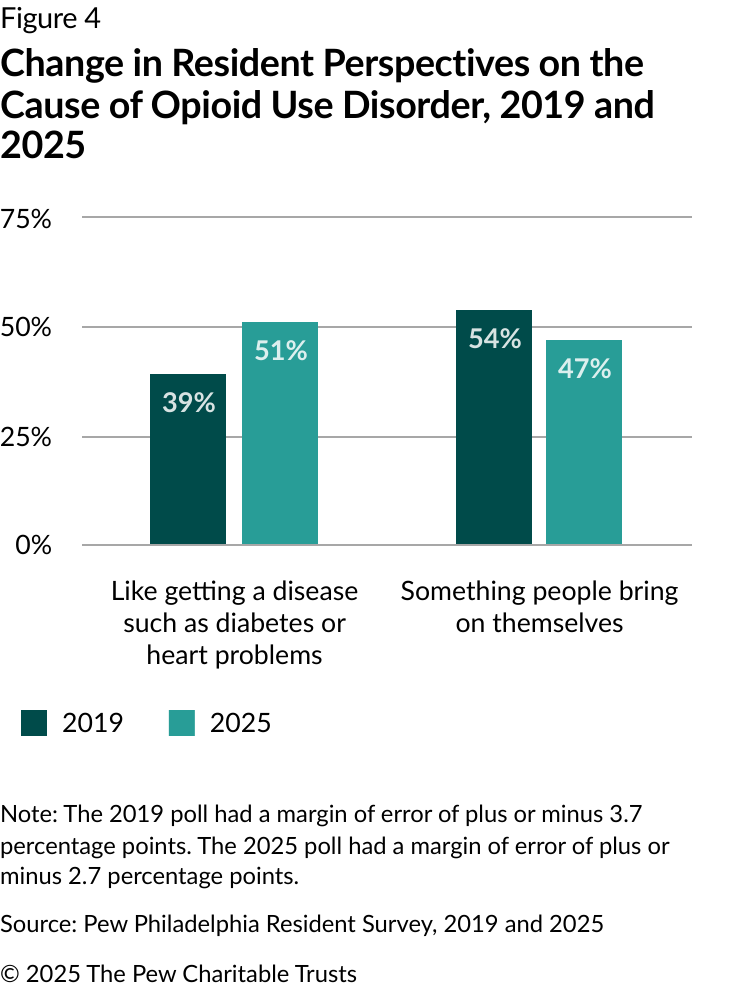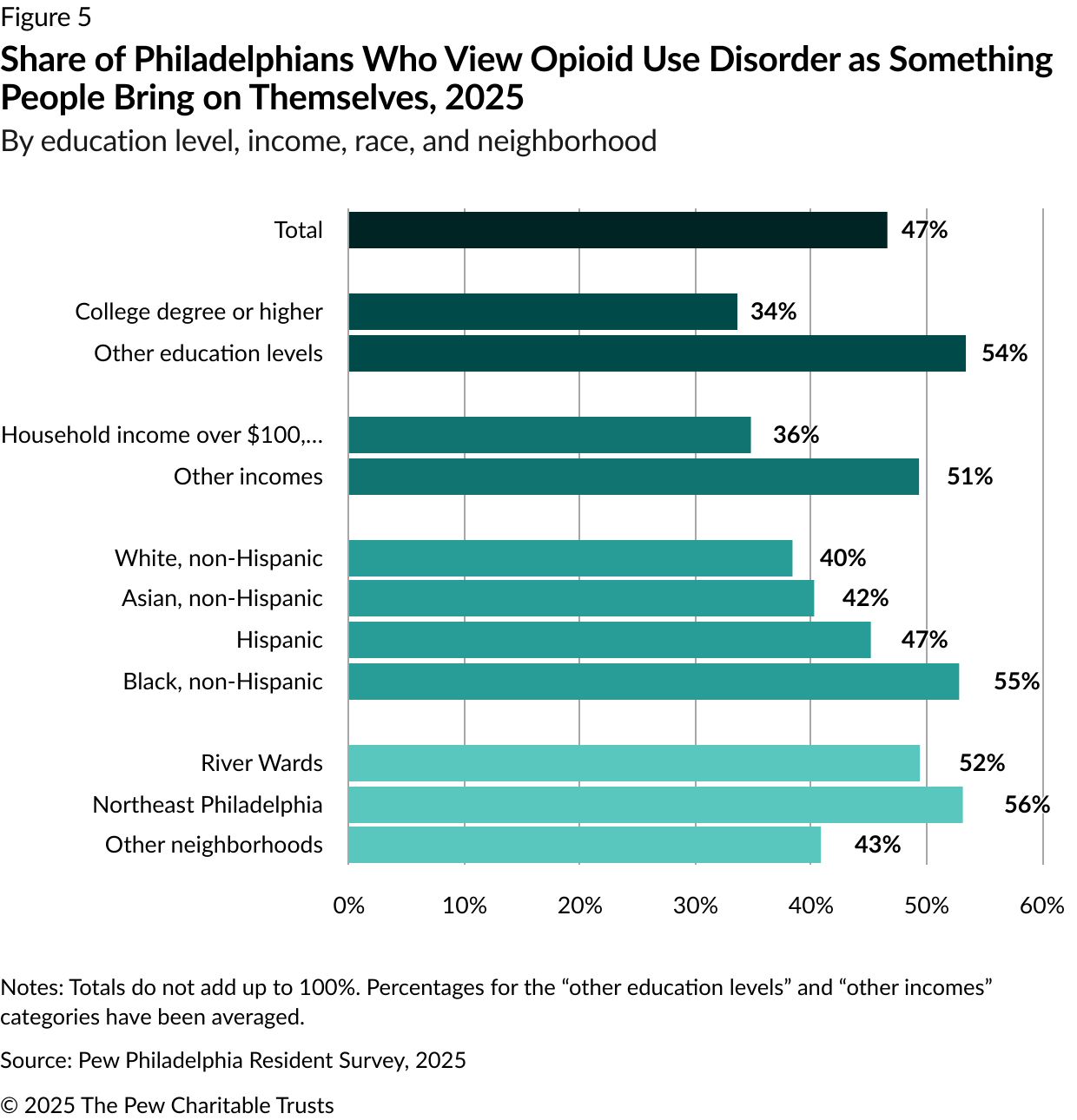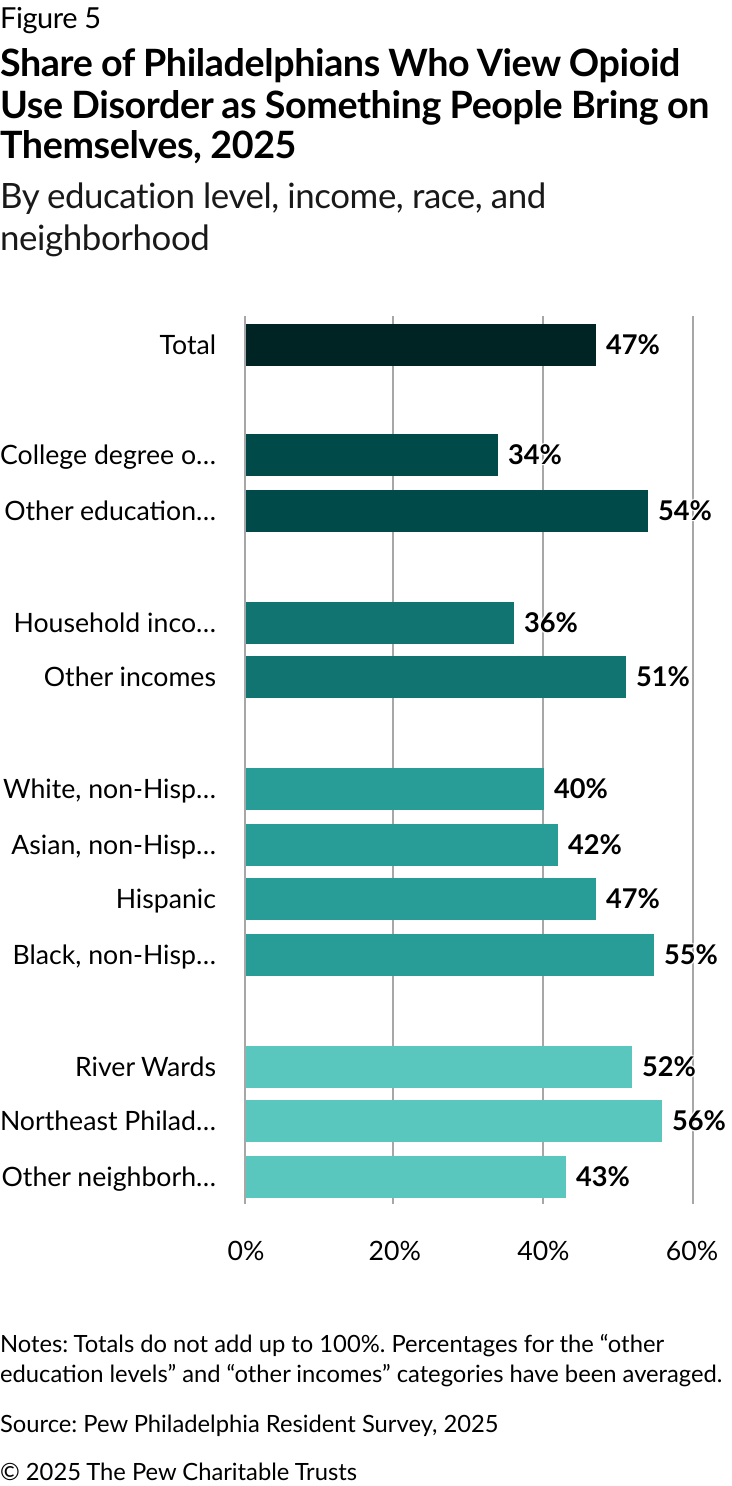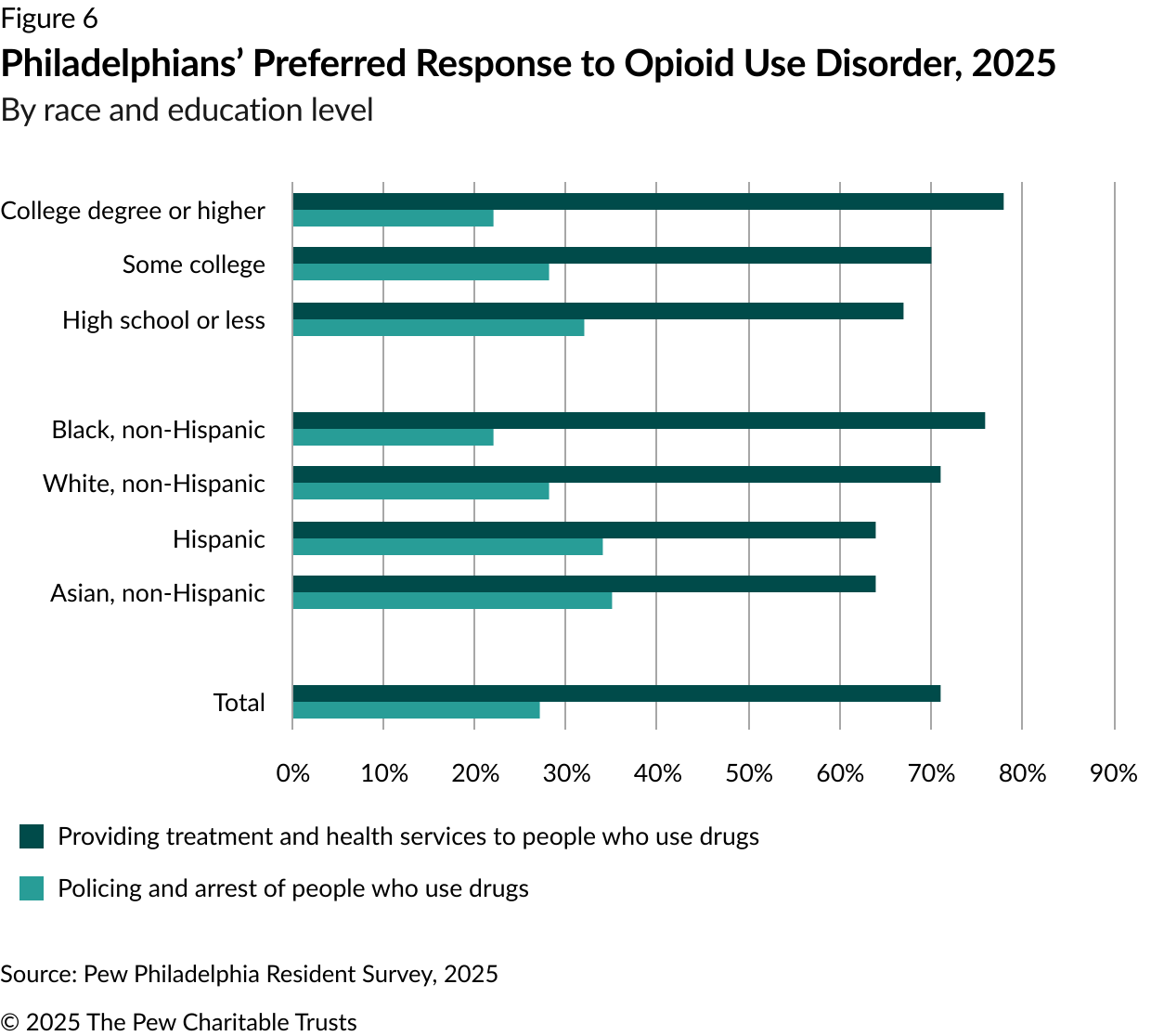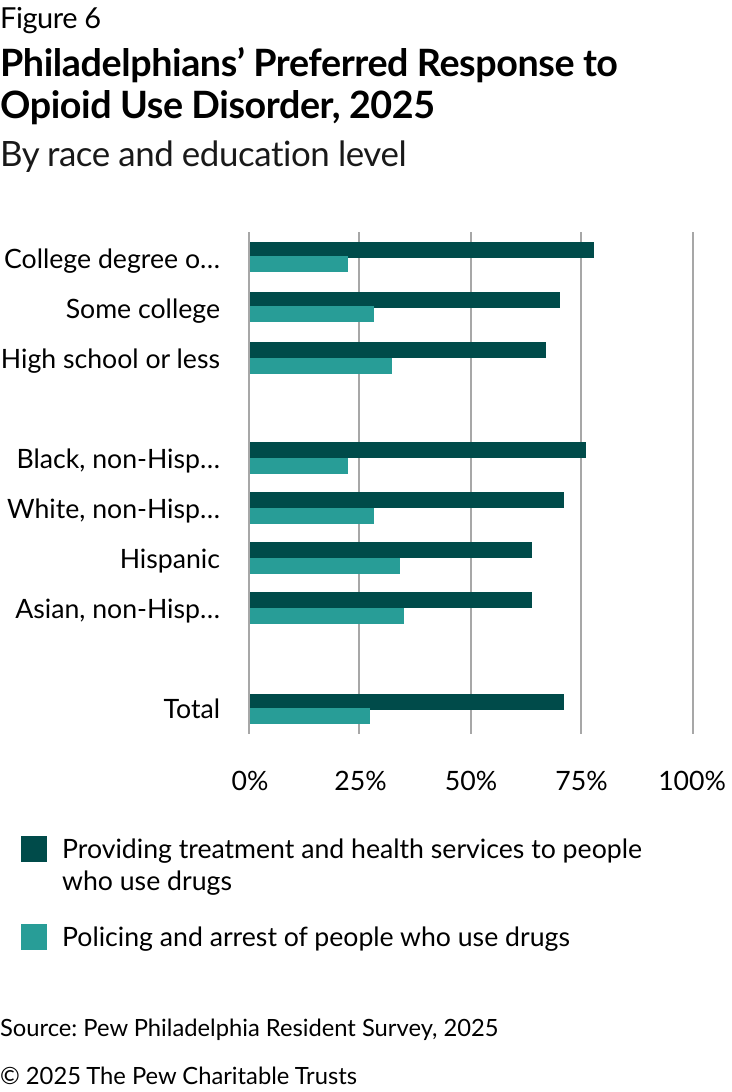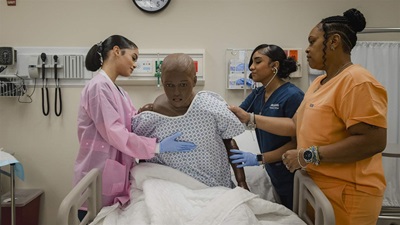Philadelphians’ Perspectives on the Opioid Crisis Are Shifting
An increasing share of residents view opioid use disorder as a chronic illness that requires treatment rather than jail time

Editor’s note: The polling toplines were updated July 8, 2025, to correct the margin of error and to include the sample of 111 phone completions of the survey in the list of survey responses.
Overview
The opioid crisis remains a pressing issue in Philadelphia, which continues to have one of the highest rates of opioid overdose deaths among large U.S. cities and counties.1 Like much of the country, Philadelphia has seen a recent decline in overdose deaths—from 1,413 in 2022 to an estimated 1,100 in 2024. This decrease has been driven by a drop in the rates for White residents, although the rates for Black residents have continued to rise. Despite the overall decline in deaths, polling of Philadelphians suggests that opioid use disorder (OUD) has had a growing impact on residents in recent years.
Since The Pew Charitable Trusts first surveyed Philadelphians in 2019 about the impact that the opioid crisis has had on their lives and their communities, residents’ perceptions have evolved—and negative impacts have become more pronounced. The direct repercussions of the opioid crisis are broadly shared across demographic groups throughout the city, according to Pew’s 2025 Philadelphia Resident Survey.
Among the key findings this year:
- Nearly half of Philadelphians (44%) personally know someone with OUD,2 up from 31% in 2019.
- 1 in 3 Philadelphians personally know someone who has died from an overdose.
- An increasing number of residents (51%) recognize OUD as a chronic health condition rather than believing that the disorder is something that people bring on themselves, up from 39% in 2019.
- Most Philadelphians (71%) would prioritize providing treatment and health services to people who use drugs rather than arresting them (27%).
The 2025 Philadelphia Resident Survey—conducted Jan. 2 through March 10, 2025, for Pew by SSRS, an independent research company based in Glen Mills, Pennsylvania—used address-based sampling, as individuals were originally contacted by mail. The poll focused on multiple issues, including public safety, views of Mayor Cherelle Parker, perceptions of government responsiveness, immigration, and personal finance. SSRS collected data from 2,289 adults—1,776 filled out the questionnaire online, 402 on paper, and 111 over the phone. The margin of error for results involving all respondents is plus or minus 2.7 percentage points, and the analysis includes weighted percentages among all valid respondents.
The impact of the opioid crisis
Rates of unintentional overdose deaths in Philadelphia remain high, and the crisis continues to affect the quality of life in residents’ neighborhoods. Nearly 4 in 10 (39%) believe the problem is worsening—especially those who live in the River Wards, which include the neighborhoods of Kensington, Fishtown, Bridesburg, and Port Richmond. About 1 in 3 (31%) see no change, while only 8% of Philadelphians think the situation is improving.
The perception that the opioid problem is getting worse may be due in part to more residents citing that they personally know individuals with OUD. This year, 44% of Philadelphians said they know someone with OUD, and more than 1 in 3 (34%) know someone who has died because of opioid use. These figures are up from 31% and 29%, respectively, in 2019. (See Figure 1.) Individuals between the ages of 30 and 64, non-Hispanic White residents, and those living in the River Wards are most likely to report knowing someone who struggled with or died from opioid use. Philadelphians ages 18-29, Asian residents, and people living in Center City were less likely to personally know someone with the disorder.
Residents have also indicated that the opioid crisis negatively affects the quality of life in their neighborhoods more significantly now than before the COVID-19 pandemic. Nearly half of Philadelphians (47%) reported a negative impact, with 19% describing it as major, while fewer than a third stated that it does not affect their lives. Although the percentage of those reporting a negative impact is slightly lower in 2025 than in 2022, it is a marked increase from before the pandemic in 2019, when 41% reported a negative impact and more than half (57%) said it made no difference. (See Figure 2.)
Residents of the River Wards continue to be the most heavily affected, with 76% reporting a negative impact in 2025, up from 64% in 2019. (See Figure 3.)
Changing perspectives on opioid use
Although more Philadelphia residents are being negatively affected by the opioid crisis, more people also seem to have a better understanding of OUD as a medical condition and a public health issue, which is changing attitudes and beliefs about how best to address it.
In the 2025 poll, 51% of residents reported understanding OUD as comparable to a disease such as diabetes or heart problems, up from 39% in 2019. Meanwhile, 47% viewed OUD as something that people bring on themselves, a decrease from 54% in 2019. (See Figure 4.)
This year, residents who are younger, have higher incomes, are college graduates, and live in Center City and South Philadelphia are most likely to consider OUD a health condition. Older and lower-income residents, those with less than a college degree, and those living in the River Wards and North and Northeast Philadelphia are more likely to see the disorder as something that individuals bring on themselves. (See Figure 5.)
The level of sympathy that Philadelphia residents have toward individuals with opioid use disorder has not changed much in recent years. According to this year’s survey, 71% of residents feel a lot or some sympathy for people who become dependent on opioids, nearly the same share as in 2019 (70%). Residents with college degrees are more likely than those with other education levels to have greater sympathy (80%). Asian, non-Hispanic residents report having less sympathy (59%) than individuals in other racial and ethnic groups do.
Beliefs about the cause of OUD appear to be reflected in how Philadelphians think the city should respond to the crisis, with responses suggesting a preference for treatment over policing. Most residents (71%) support prioritizing health services for people who use drugs, while 27% favor arresting them. These responses are consistent with a 2023 Lenfest Institute poll that asked Philadelphians what should be a top priority for the city in addressing opioid use disorder. A majority of residents in the Lenfest study said that providing more free mental health services (68%) and drug treatment and recovery services (63%) was most important, while 22% said that arresting people who use drugs should be prioritized.
Pew’s 2025 survey found that younger, college-educated, non-Hispanic White, and non-Hispanic Black residents lean toward treatment, whereas older Hispanic and non-Hispanic Asian residents and those with less than a college degree tend to support policing. (See Figure 6.)
Mayor’s response to the opioid crisis
Because Kensington has long been the epicenter of the opioid crisis in Philadelphia, much of the city’s efforts have focused on that neighborhood. According to the 2025 poll, nearly 3 in 5 Philadelphians said they had heard some or a lot about Mayor Parker’s actions to address conditions in Kensington, examples of which were not provided in the poll question.
Of Philadelphians who reported being informed about the mayor’s efforts in that neighborhood, 46% said that the actions have been very (10%) or somewhat (36%) effective at addressing conditions, while 39% said that they were not very (27%) or not at all (12%) effective.
Regarding the mayor’s handling of drugs and the opioid crisis in general throughout the city, more residents were less positive. Just 28% ranked the administration’s actions as good or excellent, while 39% said they were not very good or not good. And notably, an additional 33% weren’t sure. There was not much variation across demographics in response to this question, but individuals with a college degree and those who have lived in Philadelphia for less than 10 years were least likely to approve of Mayor Parker’s actions to date.
Conclusion
Although the recent decline in overdose deaths in Philadelphia is a promising development, the relief is not felt equally by all residents, and more Philadelphians are affected by the opioid crisis now than they were before the pandemic. At the same time, an increasing number of residents recognize opioid use disorder as a chronic health condition that requires appropriate medical care, rather than punitive measures, to help people work toward recovery. The insights that Philadelphians shared in the 2025 Pew poll underscore the ongoing challenges that this pressing public health issue poses for the city and its residents—and highlight the need for continued efforts to improve conditions citywide.
Endnotes
- “CDC Wonder Database: Multiple Cause of Death Data,” U.S. Centers for Disease Control and Prevention, https://wonder.cdc.gov/mcd.html.
- The exact wording of this question was: “Do you personally know anyone who is or has been addicted to opioids?” Pew acknowledges that using the word “addicted” in poll questions may be seen as stigmatizing, but the term was chosen for clarity and public understanding.

